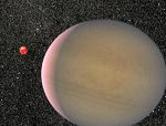 |
WASHINGTON - An international team of astronomers has discovered yet another planet far beyond our solar system, but the astronomers used a different method than the one previously used to find planets. They used a cosmic magnifying glass provided by nature.
Telescopes are not yet powerful enough to see planets orbiting distant stars, so astronomers must infer their presence. They have done this by noting a disturbance in a star's movement, a very slight, almost imperceptible wobble, meaning that the gravity of a planet was pulling on it. This technique has led to the discovery of 120 planets in distant solar systems since 1995.
Now, two international teams working together have found planet number 121 by a different method, one that takes advantage of a natural phenomenon in which a passing star acts as a lens to magnify the light from a star directly behind it.
The chief planet hunter for the U.S. space agency NASA, Charles Beichman, says this is called gravitational microlensing because it depends on the gravitational pull of the passing star on the light coming from behind it.
"If we line up two stars one exactly in front of the other, the intervening star can bend the light from the distant star and act like a cosmic magnifying glass. We can see the distant star more brightly," he said.
But if the passing star has a companion such as a planet, the brightness of the distant star behind it flares twice. This is because the planet's own gravity contributes to the effect.
German physicist Albert Einstein predicted gravitational lensing in his General Theory of Relativity. Thirteen years ago, Polish-born astronomer Bohdan Paczynski of Princeton University in New Jersey proposed using the method to detect planets outside our solar system. Now the group of astronomers of which Mr. Paczynski is a member has used the technique to observe a star-planet system 17,000 light years away.
"I consider myself really lucky as a theoretician to find that in my lifetime a prediction, to see a prediction come true. That's not all that common," he said.
The newly discovered planet is in the constellation Sagittarius. As the scientists report in the May 10th issue of "Astrophysical Journal Letters," they calculated its approximate mass by measuring the precise shape of the light curve coming from the rear star. They determined that the mass is less than half of one percent of its companion star and felt sure it must be a planet.
"It's a large, Jupiter-like planet in orbit around a dim red dwarf star," said Scottish astronomer Ian Bond of the University of Edinburgh. He says such microlensing events are not common and require the vigilance of a constant, automated sky survey to observe millions of stars. The vast majority of lensing stars do not have planets, so it is important to get as many examples as possible to increase the chances of finding one. But Mr. Bond says that it is possible to miss the planets that are there.
"It depends on things like the geometric alignment of the star-planet system and also some of these deviations are quite short. They could easily be missed in observations as well," he said.
Although all planets found outside our solar system have been about the mass of Jupiter, NASA's Charles Beichman hopes that with improved instruments, Earth-sized bodies can eventually show up.
"We're on a quest to find planets like our own around other stars. Every time we get another technique to do it, it points us in the direction of letting us know how many Earths are out there, what are the chances eventually of being able to find a planet just like our Earth in the habitable zone around a nearby star, and eventually perhaps finding evidence of life itself on such a planet," he said.
To hasten the planet search, the two cooperating international teams will soon use a bigger telescope than one in Chile it is now using and a new wide field camera to capture more of the sky in its images.
In the meantime, a consortium of astronomers has begun using a new telescope in the Canary Islands with an extremely wide field of view and a high sensitivity to brightness changes. Its job will be to look for stars that get dimmer for a short time on the theory that a planet passing in front of it will block some of its light.
* * *
You are welcome to print and circulate all articles published on Clearharmony and their content, but please quote the source.










 more ...
more ...